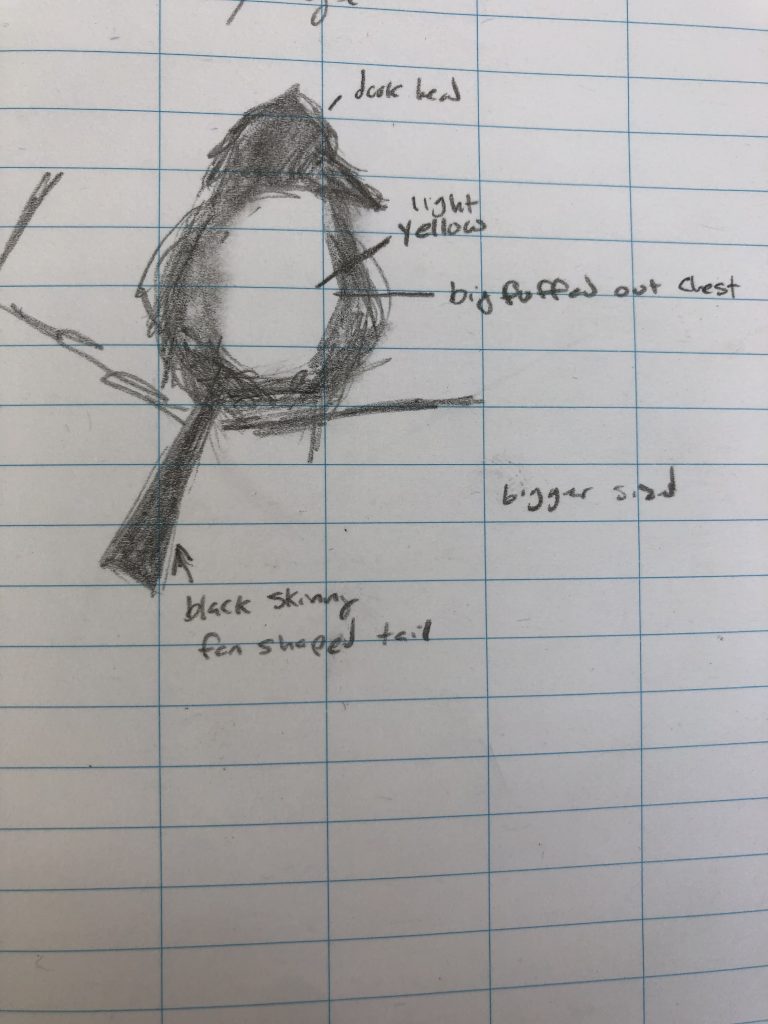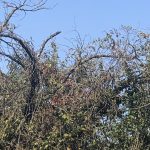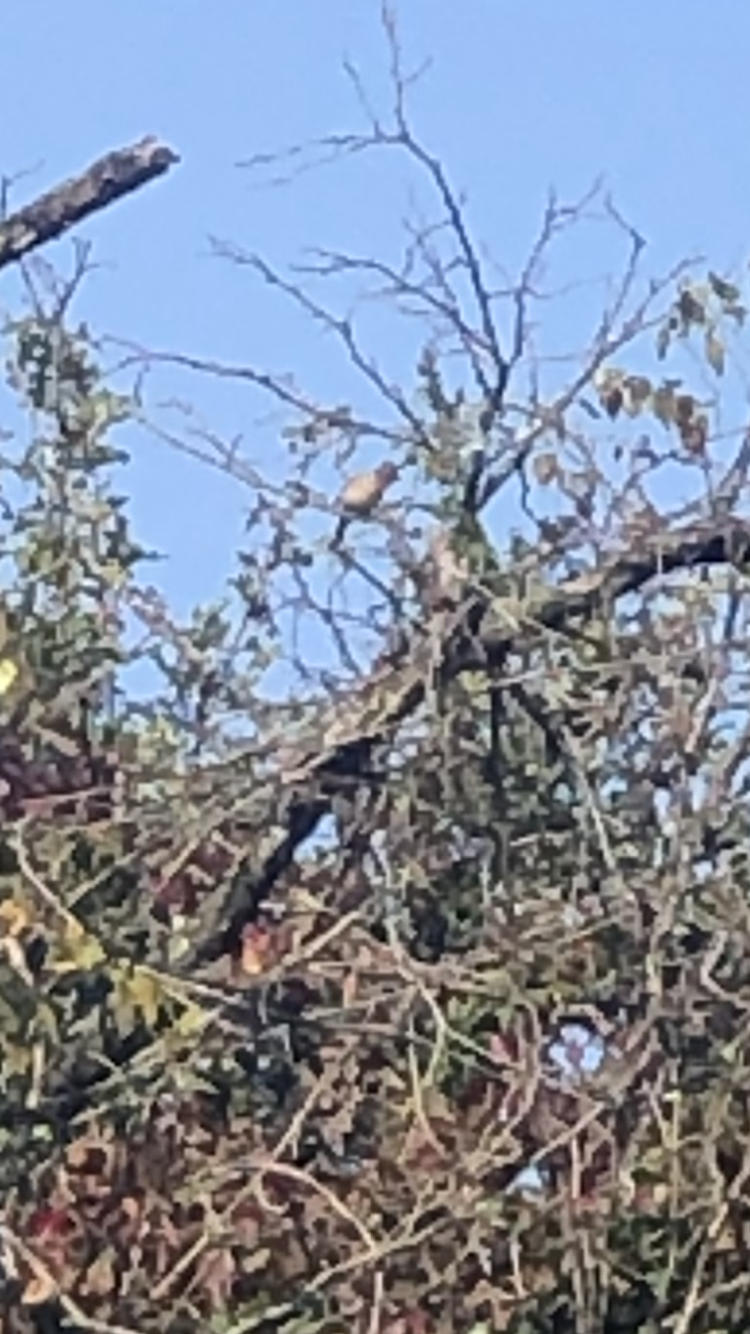
Sketch of my Observed Organism
10/4/2020, 10:06-10:46am
The organism that I picked is a bird with a big puffed out light yellow chest. It’s a bigger song bird with a thin, closed-fan shaped tail that was twitching about, accompanied by it’s long black beak. In relation to my sit-spot, the bird was west of me, perched on a tree near the fencing by my sit-spot. It was pretty high up there but it’s puffed out chest caught my eyes as well as it’s black tail. This bird, I believe is Cassin’s Kingbird, which is described by having dark olive-grey upper parts and dull yellow underparts. It’s long black tail and size (which was small), fits the description well. I picked the Cassin’s Kingbird because after a failed squirrel observation (which wouldn’t have worked anyway since I knew it was a grey squirrel), this bird was staying still, and it stood out amongst the other birds perched among the branches of the willowy trees.
This light yellow, puffy chested bird first drew me in with movement as it swiveled its tail side-to-side distractingly. I watched it and earnestly prayed that it would not fly away as I was already haunted from my first failed observation. But instead, all I observed was the bird ruffling its feathers before digging its beak between the layers and shaking its head side-to-side real fast. I watched patiently (yet still anxiously) as a couple bigger black birds flew overhead and the bird seemed to shuffle around nervously on its feet, holding on surely to the thin branch. It seems to me this bird was always aware, as its head was constantly swiveling, side to side, checking around for any lurkers (me) or danger.

Tree Cassin’s Kingbird Was Observed In
Suddenly, right when I was feeling good, like this bird was going to stay for a bit more of time, I watched as it roused itself a bit before opening its feathers and flying down towards the fence I was leaning against to observe it. It lands on the fence a good amount of feet from where I was and I listen as it makes this sharp sounding click-like chirp that came like an alarm; on repeat. And to my astonishment, an identical sound answered back to the call I didn’t know was a call, back from the woods, lower down. Was it a baby, a mate, or just another of the same species answering the call? Was it trying to warn the birds in the woods of my presence, or the presence of the horses in the field aways away that started to come closer
Some of the natural history information I found on this fly catching species, Cassin’s Kingbird, is that they prefer many environments, one being agricultural areas, which is where mine is located. Really, they prefer environments that provide optimal fly catching, but other insects, as well as fruit, are other options for them as well. To hunt, these birds perch on an elevated height to be able to fly down quickly and catch insects midair. Behavior-wise, at the beginning of the breeding season, male Cassin’s Kingbirds establish and defend territories with atleast one main feeding site, such as a tall tree. The males are very vocal at all times of day, and to show dominance to other birds, they may crouch, droop the wings, and flick the tail, which is what the bird I observed had done. Males will also stay close to the nest tree when paired, and call in response to other males nearby (Is this perhaps what I had witnessed with my ears?). For the females, they build the nest and incubate the eggs, while the males forage and watch out for predators on a close-by perch.
To identify my observed bird, Cassin’s Kingbird, I first read what I wrote as a description of the bird and looked that up online. I then looked at my pictures and picked out key features to look out for. Once I found a bird that I thought may be the species of the bird I observed, I listened to the sound it makes, provided by the website, and compared that to the sound I had heard (remembering from memory and my written description of the bird). Finally, down between a bird species called, “MacGillivray’s Warbler,” and, “Cassin’s Kingbird” I finally deduced that the bird’s tail I observed was much longer as well as it had a slight tuft on its head that stuck-up to a faint point, which MacGillvray’s Warbler did not have. This identification was challenging because at first I lacked confidence, feeling as if I’d never find out what bird this species could possibly belong to, but being able to narrow it down to birds in Virginia, and being able to actually hear the sound the bird made, helped a lot.
Overall, honestly, this was difficult, but only because I decided to observe a fast moving organism that can easily fly out of sight. However, this was also very cool, to just stare at a bird for 30 minutes and take into account every detail, to make inquires, and have them answered real-time. Oh! And something random yet perhaps interesting, is after hearing the answering call of another Cassin’s Kingbird that I could not see, I walked towards the sound, rounded the fence, and saw huge bushes stacked tall containing thousands of red berries; enlightening sense as to why the area was so popular with birds. Anyways, back to the conclusion: Taking notes in real time while observing was a bit difficult as you need to look away from the organism for a good amount of time to record each observation, but to do that, things are missed about the bird as you write, as well as, the chance of it leaving is higher chanced. So, was it slightly stressful? Yes. But as always, the sit-spot forced me to quiet my mind and just take nature in. Also, identifying the organism was cool, as I feel like a “real” bird-watcher now.


Yes! Look at you, you bird watcher! I very much enjoyed reading your description of your experience, Emmaline. It’s so neat that there are bushes with red berries! I’ll definitely have to look for them in hopes that I might see a Cassin Kingbird.